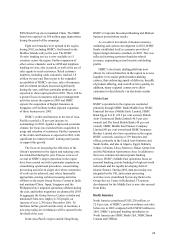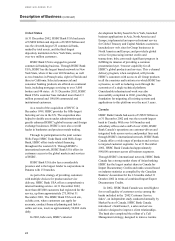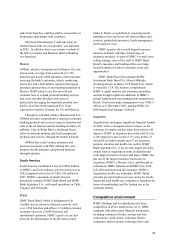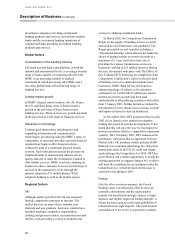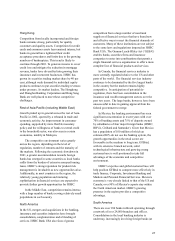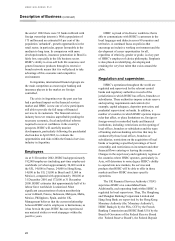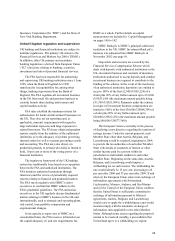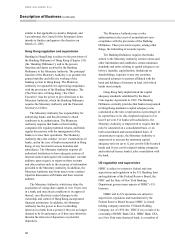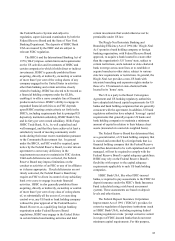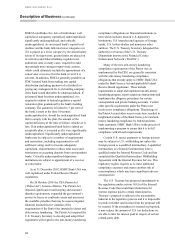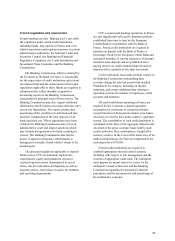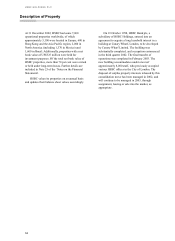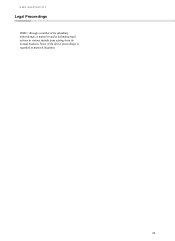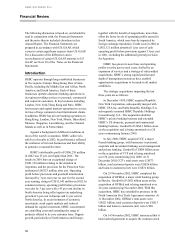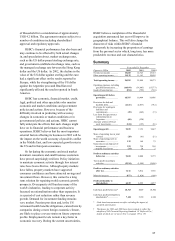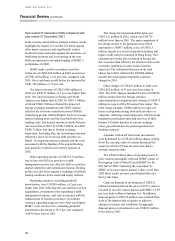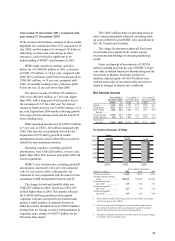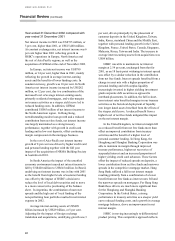HSBC 2002 Annual Report Download - page 32
Download and view the complete annual report
Please find page 32 of the 2002 HSBC annual report below. You can navigate through the pages in the report by either clicking on the pages listed below, or by using the keyword search tool below to find specific information within the annual report.
HSBC HOLDINGS PLC
Description of Business (continued)
30
similar to that applicable to Austria, Belgium, and
Luxembourg), the Council of the European Union
intends to finalize and approve the directive on
March 21, 2003.
Hong Kong regulation and supervision
Banking in Hong Kong is subject to the provisions of
the Banking Ordinance of Hong Kong (Chapter 155)
(the ‘Banking Ordinance’ ), and to the powers,
functions and duties ascribed by the Banking
Ordinance to the Monetary Authority. The principal
function of the Monetary Authority is to promote the
general stability and effective working of the
banking system in Hong Kong. The Monetary
Authority is responsible for supervising compliance
with the provisions of the Banking Ordinance. The
Chief Executive of Hong Kong (‘the Chief
Executive’ ) has the power to give directions to the
Monetary Authority, which the Banking Ordinance
requires the Monetary Authority and the Financial
Secretary to follow.
The Monetary Authority has responsibility for
authorising banks, and has discretion to attach
conditions to its authorisation. The Monetary
Authority requires that banks or their holding
companies file regular prudential returns, and holds
regular discussions with the management of the
banks to review their operations. The Monetary
Authority may also conduct ‘on site’ examinations of
banks, and in the case of banks incorporated in Hong
Kong, of any local and overseas branches and
subsidiaries. The Monetary Authority requires all
authorised institutions to have adequate systems of
internal control and requires the institutions’ external
auditors, upon request, to report on those systems
and other matters such as the accuracy of information
provided to the Monetary Authority. In addition, the
Monetary Authority may from time to time conduct
tripartite discussions with banks and their external
auditors.
The Monetary Authority, which may deny the
acquisition of voting share capital of over 10 per cent
in a bank, and may attach conditions to its approval
thereof, can effectively control changes in the
ownership and control of Hong Kong-incorporated
financial institutions. In addition, the Monetary
Authority has the power to divest controlling
interests in a bank from a person if they are no longer
deemed to be fit and proper, or if they may otherwise
threaten the interests of depositors or potential
depositors.
The Monetary Authority may revoke
authorisation in the event of an institution's non-
compliance with the provisions of the Banking
Ordinance. These provisions require, among other
things, the furnishing of accurate reports.
The Banking Ordinance requires that banks
submit to the Monetary Authority certain returns and
other information and establishes certain minimum
standards and ratios relating to capital adequacy (see
below), liquidity, capitalisation, limitations on
shareholdings, exposure to any one customer,
unsecured advances to persons affiliated with the
bank and holdings of interests in land, with which
banks must comply.
Hong Kong fully implemented the capital
adequacy standards established by the Basel
Convergence Agreement in 1989. The Banking
Ordinance currently provides that banks incorporated
in Hong Kong maintain a capital adequacy ratio
(calculated as the ratio (expressed as a percentage) of
its capital base to its risk-weighted exposure) of at
least 8 per cent. For banks with subsidiaries, the
Monetary Authority is empowered to require that the
ratio be calculated on a consolidated basis, or on
both consolidated and unconsolidated bases. If
circumstances require, the Monetary Authority is
empowered to increase the minimum capital
adequacy ratio (to up to 12 per cent for fully-licensed
banks and 16 per cent for deposit-taking companies
and restricted-licence banks), after consultation with
the bank.
US regulation and supervision
HSBC is subject to extensive federal and state
supervision and regulation in the US. Banking laws
and regulations of the Federal Reserve Board, the
FDIC and the State of New York Banking
Department govern many aspects of HSBC’s US
business.
HSBC and its US operations are subject to
supervision, regulation and examination by the
Federal Reserve Board because HSBC is a bank
holding company under the US Bank Holding
Company Act of 1956 (the ‘BHCA’ ) as a result of its
ownership of HSBC Bank USA. HSBC Bank USA,
as a New York state-chartered bank, is a member of





